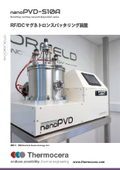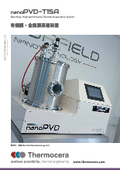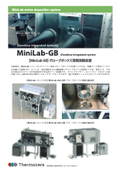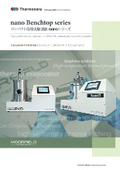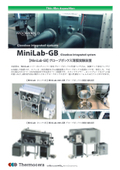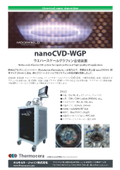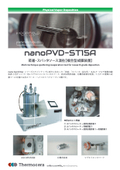真空炉『Mini-BENCH-prism 超高温実験炉』
最高使用温度2000℃ セミオート制御 超高温実験炉(カーボン炉、タングステンメタル炉) 小型・省スペース実験炉
◉最高使用温度 Max2000℃ ◉カスタマイズ自在なヒーター構造: - 円筒状ヒーター:るつぼ内サンプル焼成(固形物、粉体、粒形、ペレット形状サンプル用) - 面状ヒーター:Φ1"〜Φ6"ウエハー、小片チップ焼成用 ◉PLCセミオートコントロール タッチパネル画面で温度調節計以外の全ての操作を行います。 煩わしいバルブ開閉・ポンプ起動操作が不要、焼成作業前の「真空/パージ」サイクルと焼成作業後の「ベント」を1ボタンで自動シーケンスで行います。 ◉MFC最大3系統 自動流量制御(又は手動調整) ◉APC自動圧力コントロール ◉作業中の安全を確保 冷却水異常・チャンバー温度異常・過圧異常を監視SUS製 堅牢な水冷チャンバー、最高温度で連続使用中でも安全にご使用いただけます。 ◉小型・省スペース 幅603 x 奥行603 x 高さ1,160mm(*ロータリーポンプ筐体内設置) 実験室での小片試料の超高温加熱実験、新素材研究開発などのさまざまな試料加熱実験が、簡単な操作で行えます。 本体は小型でありながらよりさまざまな分野の研究開発にお使いいただけます。
基本情報
◆基本仕様◆ ・ヒーター:C/Cコンポジット, PGコートC/Cコンポジット(カーボン炉), タングステン(メタル炉) ・断熱材:グラファイトフェルト材(カーボン炉), タングステン/モリブデン,TaCコートグラファイト(メタル炉)、又はW/Mo多層シールド ・面状ヒーター加熱範囲:Φ2inch〜Φ6inch ・円筒状ヒーター加熱範囲:Φ30〜Φ80 x 深さMax100(H)mm ・7inchタッチパネル操作 ・デジタル真空計 ・MFC最大3系統自動調整(又はフロートメーター手動流量調整) ・温度制御:デジタルプログラム調節計、C熱電対 ・到達真空度:1x10-2Pascal(*但し空炉の場合) ・一次側電源仕様:AC200V 50/60HZ 三相 50A NFB ・冷却水:8L/min, 0.4Mpa 25〜30℃ ◆オプション◆ ・真空排気系:ロータリーポンプ, 高真空ポンプ, バルブ類
価格情報
-
納期
型番・ブランド名
Mini-BENCH-prism
用途/実績例
◆主な応用アプリケーション◆ ・新素材開発 ・材料分析 ・その他各種先端材料開発に応用
カタログ(37)
カタログをまとめてダウンロードこの製品に関するニュース(6)
-

多元マルチスパッタリング装置【MiniLab-125】Φ8"対応 SiCコーティング 1000℃ヒーターステージ 搭載!コンパクトサイズ!
多元マルチスパッタリング装置(Φ8inch基板対応) ・3元同時成膜 + 1元PulseDCスパッタ ・RF500W, DC850W両電源を3元カソード(Source1, 2, 3)へ自在に配置変更 ・5KW PulseDC電源も搭載 → 専用カソード(4)で使用 ・基板加熱ステージ Max800℃(SiCコーティングヒーターでMax1000℃も可能) ・MFC x 3系統(Ar, O2, N2)反応性スパッタリング ・メインチャンバー RIEエッチングステージRF300W ・LLチャンバー <30W 低出力制御ソフトエッチング ・独自の"Soft-Ething"技術で基板バイアスにより基板のダメージを軽減 ・タッチパネル又はWindows PC操作:操作が分散せず、全ての操作をタッチパネル/PCで行うことができます。 ・装置設置寸法:1,960(W) x 1,100(D) x 1,700(H)mm ・マルチチャンバー式も製作可能です。 ●抵抗加熱蒸着・有機材料蒸着・EB蒸着・PECVDなどの混在仕様も構成可能です。
-

4元マルチスパッタ装置 【MiniLab-S060】
Φ2inchカソード x 4基搭載 同時成膜:3元同時成膜(RF500W or DC850W)+ HiPIMS(PulseDC 5KW) x 1 プラズマリレーSWでHMI画面より自在に4カソードへの電源分配・配置設定の変更が可能 MFC x 3系統(Ar, O2, N2)反応性スパッタリング RIEエッチングステージRF300W(メインチャンバー) + <30Wソフトエッチング(LLチャンバー) 基板加熱:Max500℃, 800℃, 又は1000℃(C/C、又はSiCコート) 基板回転・上下昇降(ステッピングモーター自動制御) APC自動制御:アップストリーム(MFC流量調整)又はダウンストリーム(排気側バルブ自動開度調整) 寸法:1,120(W) x 800(D) ●抵抗加熱蒸着・有機材料蒸着・EB蒸着・PECVDなどの混在仕様も構成可能です。
-

【MiniLab】 蒸着/スパッタ・デュアルチャンバーシステム
2台の薄膜実験装置をロードロック機構で連結。異なる成膜装置(スパッタ - 蒸着、など)をロードロックでシームレスに連結。Moorfield社独自のロードロックシステムにより、左右・後方へのプロセス室への連結も可能(写真下)。 1. MiniLab-E080A(蒸着装置) ・EB蒸着:7ccるつぼ x 6 ・抵抗加熱蒸着 x 2 ・有機蒸着限 x 2 2. MiniLab-S060A(スパッタリング装置) ・Φ2"マグネトロンカソード x 4源同時スパッタ ・DC, RF両電源対応 3. Load Lockチャンバー ・プラズマエッチングステージ ロードロック室では「RF/DC基板バイアスステージ」による基板表面のプラズマクリーニング、又、同社独自の『ソフトエッチング』技術による<30W 低出力・ダメージレスプラズマエッチングステージも搭載可能。2D(PMMA等のレジスト除去など)、グラフェン剥離、又、テフロン基板などのダメージを受けやすい繊細なエッチングプロセスも可能。(*メインチャンバーステージへも搭載可能です)
-

☆★☆スパッタ・蒸着ソース複合型成膜装置【nanoPVD-ST15A】☆★☆
スパッタカソード・蒸着ソース混在型薄膜実験装置 コンパクトフレームに金属蒸着・有機蒸着・スパッタカソードを設置 抵抗加熱蒸着源(金属蒸着)、有機蒸着源(有機材料)、マグネトロンスパッタ(金属・絶縁材)、3種類の成膜コンポーネントをチャンバー内に設置、様々な薄膜実験装置に1チャンバーで対応が可能です。 ◉組み合わせは3種類 1. スパッタカソード + 抵抗加熱蒸着源x2 2. スパッタカソード + 有機蒸着源x2 3. スパッタカソード + 抵抗加熱源x1 + 有機蒸着源x1(*DCスパッタのみ) 【仕様】 ◉ 対応基板:〜Φ4inch ◉ スパッタリング:2"カソード x 最大3源 ◉ 真空蒸着:抵抗加熱蒸着(最大2)、有機蒸着(最大4) ◉ 7"タッチパネル操作 PLC自動プロセスコントロール ◉ APC自動圧力制御 ◉ Arガス1系統(標準) + N2, O2 増設可能 ◉ USB端子付 Windows PCに接続し、レシピ作成・保存。PCでデータロギング ◉ 他、多彩なオプションを用意 ◉ 7"タッチパネル簡単操作 PLC自動プロセスコントロール
-

蒸着/スパッタ・デュアルチャンバーシステム【MiniLab-E080A/S060A】
2台の薄膜実験装置をロードロック機構で連結。異なる成膜装置(スパッタ - 蒸着、など)をロードロックでシームレスに連結。Moorfield社独自のロードロックシステムにより、左右・後方へのプロセス室への連結も可能(写真下)。 1. MiniLab-E080A(蒸着装置) ・EB蒸着:7ccるつぼ x 6 ・抵抗加熱蒸着 x 2 ・有機蒸着限 x 2 2. MiniLab-S060A(スパッタリング装置) ・Φ2"マグネトロンカソード x 4源同時スパッタ ・DC, RF両電源対応 3. Load Lockチャンバー ・プラズマエッチングステージ ロードロック室では「RF/DC基板バイアスステージ」による基板表面のプラズマクリーニング、又、同社独自の『ソフトエッチング』技術による<30W 低出力・ダメージレスプラズマエッチングステージも搭載可能。2D(PMMA等のレジスト除去など)、グラフェン剥離、又、テフロン基板などのダメージを受けやすい繊細なエッチングプロセスも可能。(*メインチャンバーステージへも搭載可能です)
おすすめ製品
取り扱い会社
【Endless possibility_thermal engineering...】 当社は半導体・電子機器基礎研究用真空薄膜装置、CVD基板加熱用超高温ヒーター、実験炉、温度計測機器などを販売しております。 いつの時代でも欠かす事のできない「熱」に対する尽きぬ需要、基礎技術開発分野での様々なご要求にお応えすべく、最新の機器を紹介し、日本の研究開発に貢献してまいりたいと考えます。















